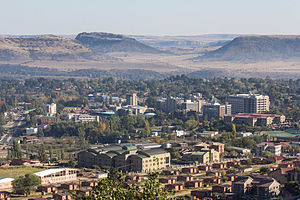
Back اقتصاد ليسوتو Arabic Economía de Lesothu AST Economia de Lesotho Catalan Ekonomika Lesotha Czech Wirtschaft Lesothos German Economía de Lesoto Spanish Économie du Lesotho French Economía de Lesoto Galician כלכלת לסוטו HE Ekonomio di Lesoto IO
 Maseru, the economic hub of Lesotho | |
| Currency | Lesotho Loti |
|---|---|
| 1 April - 31 March | |
Trade organisations | WTO, SACU, SADC |
Country group | |
| Statistics | |
| GDP | $2.13 billion nominal (2010 est.) $2.73 billion (2019) |
GDP growth |
|
GDP per capita | $1,670 Purchasing Power Parity (PPP) (2011 est.) |
| 3.1% (2010 est.) | |
Population below poverty line | 58% using national poverty line (2002/03), 37 percent using World Bank $1 a day (2002/03)[4] |
Labour force | 855,000 (2007) |
Labour force by occupation | agriculture: About 80% of the resident population are engaged in subsistence agriculture; roughly 20% of the formal wage earners (about 200,000) work (mainly males) in South Africa, 20% of the workers (mainly females) are in the apparel industry in Lesotho, and 20% are employed by the Government of Lesotho. The others are employed in services and other manufacturing (2008). |
| Unemployment | 24%-28% |
Main industries | food, beverages, textiles and apparel, handicrafts, construction, tourism, mining |
| External | |
| Exports | $1,043 million f.o.b. (2010 est.) |
Export goods | Garments 53% , other including diamonds 47% (2008) |
Main export partners | SACU 19% (2007) |
| Imports | $1,766 million c.i.f. (2010 est.) |
Import goods | food, building materials, vehicles, machinery, medicines, petroleum products, inputs to the apparel industry (2010) |
Main import partners | SACU 85% |
| Public finances | |
| $647 million (33% of GDP) (31 December 2010 est.) | |
| Revenues | $1,232 million (57% of GDP) (2009/10) |
| Expenses | $1,168 million (2009/10) |
All values, unless otherwise stated, are in US dollars. | |
The economy of Lesotho is based on agriculture, livestock, manufacturing, mining, and depends heavily on inflows of workers’ remittances and receipts from the Southern African Customs Union (SACU).[5][6] Lesotho is geographically surrounded by South Africa and is economically integrated with it as well. The majority of households subsist on farming. The formal sector employment consist of mainly female workers in the apparel sector, while male migrant laborers work primarily either as miners in South Africa for 3 to 9 months or in the employment of the Government of Lesotho (GOL). Half of the country's population work in informal crop cultivation or animal husbandry.
Lesotho, is a member of the Southern African Customs Union (SACU) in which tariffs have been eliminated on the trade of goods between other member countries, which also include Botswana, Namibia, South Africa, and Eswatini. Lesotho, Eswatini, Namibia, and South Africa also form a common currency and exchange control area known as the Rand Monetary Area that uses the South African rand as the common currency. In 1980, Lesotho introduced its own currency, the loti (plural: maloti). One hundred lisente equal one loti. The Loti is at par with the rand.
- ^ "World Economic Outlook Database, April 2019". IMF.org. International Monetary Fund. Retrieved 29 September 2019.
- ^ "World Bank Country and Lending Groups". datahelpdesk.worldbank.org. World Bank. Retrieved 29 September 2019.
- ^ "Global Economic Prospects, January 2020 : Slow Growth, Policy Challenges" (PDF). openknowledge.worldbank.org. World Bank. p. 147. Retrieved 22 January 2020.
- ^ "LESOTHO Sharing Growth by Reducing Inequality and Vulnerability: A Poverty, Gender, and Social Assessment" (PDF). World Bank.
- ^ "World bank Lesotho: Country Brief". Archived from the original on 2014-03-31. Retrieved 2012-03-03.
- ^ "CIA Lesotho Economy 2011". Retrieved 2012-03-03.